Trade Management Software Market Size
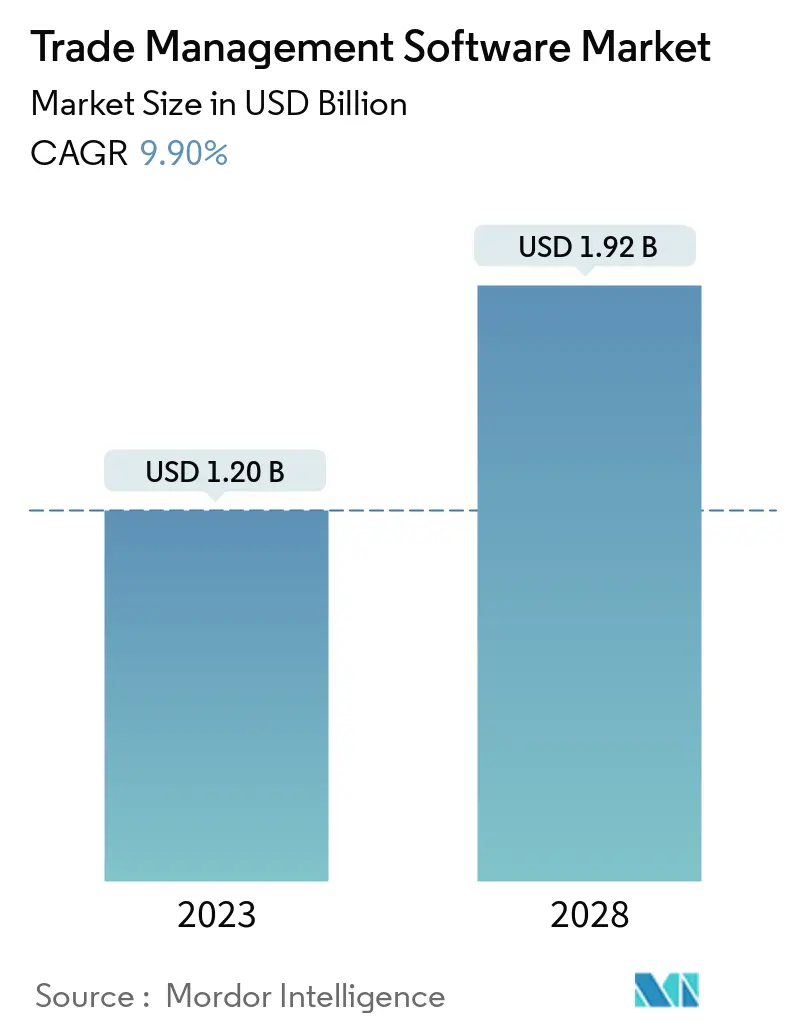
| Study Period | 2018 - 2028 |
| Market Size (2023) | USD 1.20 Billion |
| Market Size (2028) | USD 1.92 Billion |
| CAGR (2023 - 2028) | 9.90 % |
| Fastest Growing Market | Middle East and Africa |
| Largest Market | North America |
Major Players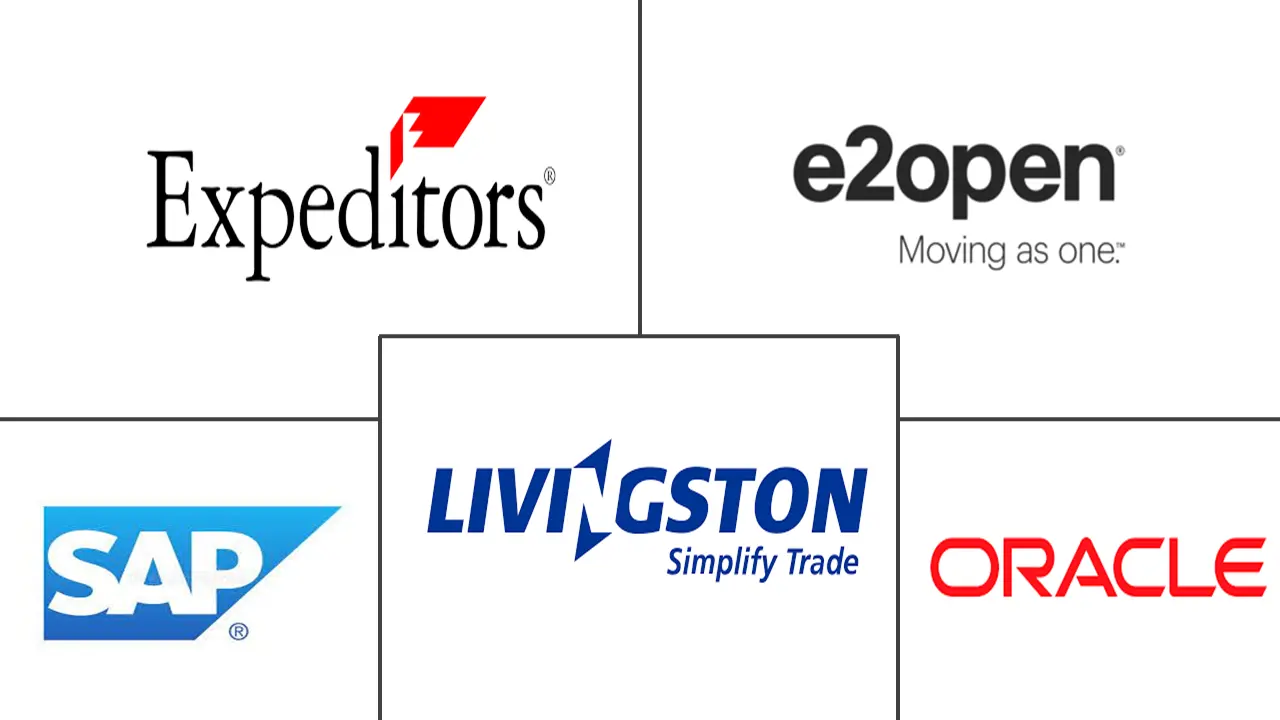
*Disclaimer: Major Players sorted in no particular order |
Need a report that reflects how COVID-19 has impacted this market and its growth?
Trade Management Software Market Analysis
The Trade Management Software Market size is estimated at USD 1.20 billion in 2023, and is expected to reach USD 1.92 billion by 2028, growing at a CAGR of 9.90% during the forecast period (2023-2028).
Rising company concerns about changing rules, trade agreements, and their impact on businesses' supply chains are an essential part of the market. Increasing government requirements in many nations are projected to fuel demand for trade management software.
- Growing demands for trade management automation technology and the rising need to minimize organizational expenses are among the main factors driving market expansion. The market studied is based on the revenue from trade management software sales for various end-user applications.
- Moreover, trade management software includes capabilities that assist traders and businesses in lowering supply chain and legal risks. It connects importers and exporters with overseas suppliers, brokers, logistic service providers, and carriers. Companies use the program to monitor and track cross-border operations. The program reduces risk and aids in the effective management and administration of imports-exports and legal and regulatory standards by automating the cooperation of cross-border operations.
- Globalization and outsourcing have caused supply networks to become increasingly complex and dispersed globally. These developments reinforce the product offering of supply chain visibility solutions, which also increase the volume of international trade, the need for solutions to enhance it, and the number of products subject to compliance, customs, and tariffs.
- The COVID-19 outbreak hampered international trade. To prevent the coronavirus spread, authorities in several nations imposed global transportation and trade limitations. Such restrictions and social alienation disrupted the distribution network and international trade. Sales in the chemical and automotive sectors fell significantly in developed economies such as the United States, the European Union, and China. Textiles, office machinery, precise instruments, and communications equipment have all experienced a significant drop in trade.
- However, following the pandemic, the industry experienced faster digital transformation for enterprises of all sizes across all sectors. This rapid digital revolution is expected to boost global trade, commerce, and employment generation. As per the Asian Development Bank's Asian Economic Integration Study 2021, a 20% increase in the size of the digital industry is expected to increase global production by USD 4.3 trillion between 2021 and 2025.
Trade Management Software Market Trends
This section covers the major market trends shaping the Trade Management Software Market according to our research experts:
Consumer Goods to Drive the Market
- Consumer goods companies can adopt trade management software to manage trade-related processes such as import/export management, restricted party screening, trade compliance, custom filings, free trade zones, and cross-border trade management. International trade refers to economic transactions between countries. Consumer products such as clothing and television sets, capital goods such as machinery, raw materials, food, and other goods are frequently traded.
- Many global consumer goods companies use a centralized platform to gather trade expenditure information from various markets and channels for reporting and decision-making throughout the organization. The platform frequently includes data regarding trade partners' margin needs, based on a reverse-engineering study, to make it evident what type of agreement trading partners like.
- Trade promotion management (TPM) and trade promotion optimization (TPO) is the processes and technologies that consumer goods producers use to plan, manage, and execute operations that need collaborative promotional engagement from their retail partners.
- The consumer goods industry is experiencing several difficulties, including inflation-driven cost rises, tighter margins, and global supply chain concerns, all of which can contribute to lower sales and brand loyalty. As a result of the economic instability, the consumer goods industry is seeking digital solutions to make its operations more effective and robust.
- According to the US Census Bureau, in September 2022, the overall value of the United States imports was nearly USD 275.41 billion. Its exports were valued at around USD 176 billion that month, and in January, the overall value of the United States imports was nearly USD 247.9 billion. Its exports were valued at roughly USD 147.4 billion that month. The expanding number of imports and implementing trade management software assists firms in optimizing the costs and risks associated with international trading.
- Consumer products manufacturers can adopt Trade Management Software to balance trade investment needs from retail partners with their requirements to deliver revenue and volume growth, as well as higher margins and ROI, through integrated sales planning.
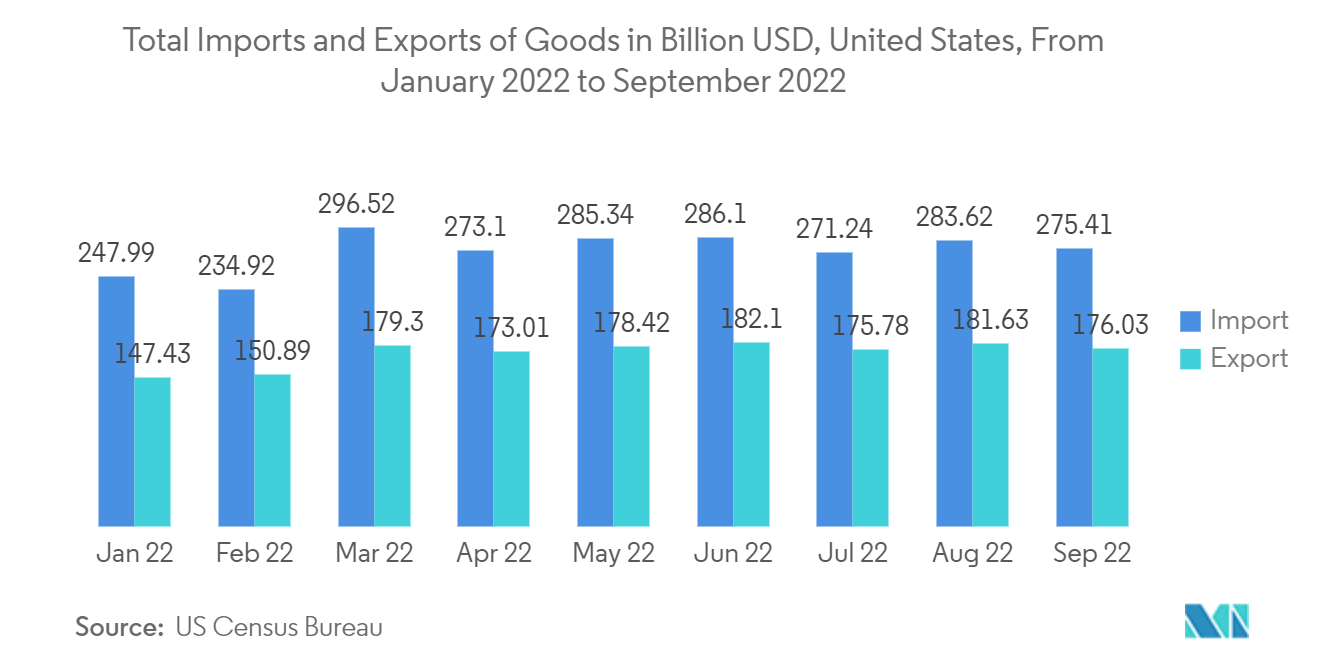
North America Expected to Hold Major Market Share
- The presence of key competitors such as SAP, Oracle, and Amber Road Inc. is projected to provide North America with a considerable market share in the trade management software industry.
- Additionally, the region's quick and stringent trade rules increase the demand for these solutions to ensure seamless compliance and no missed tax and duty deadlines.
- The US government intends to expand its share of locally created goods. Thus, export growth will be comparable to that of international imports. As a result, the usage of trade management software is likely to increase further to track and adhere to each country's regulatory rules.
- Furthermore, the trade management software industry will likely profit from North America's increasing cloud-based solutions market.
- In March 2022, Canada contributed CAD 200,000 (~USD 150,000) to assist developing and least-developed countries in becoming more active participants in global agricultural commerce. The funding to the Standards and Trade Development Facility (STDF) will help nations fulfill international safety of food, plant, and animal health standards, allowing them to access regional and global markets more readily.
- According to BEA, the overall amount of trade products and services imported into the United States climbed from USD 795.5 billion in Q1 2021 to USD 1,018.5 billion in Q1 2022. The increased trade products and services imported into the United States are expected to boost demand for trade management software.
- Other regional companies are involved in various activities such as acquisition, merger, and partnership, which are expected to increase the demand for trade management software.
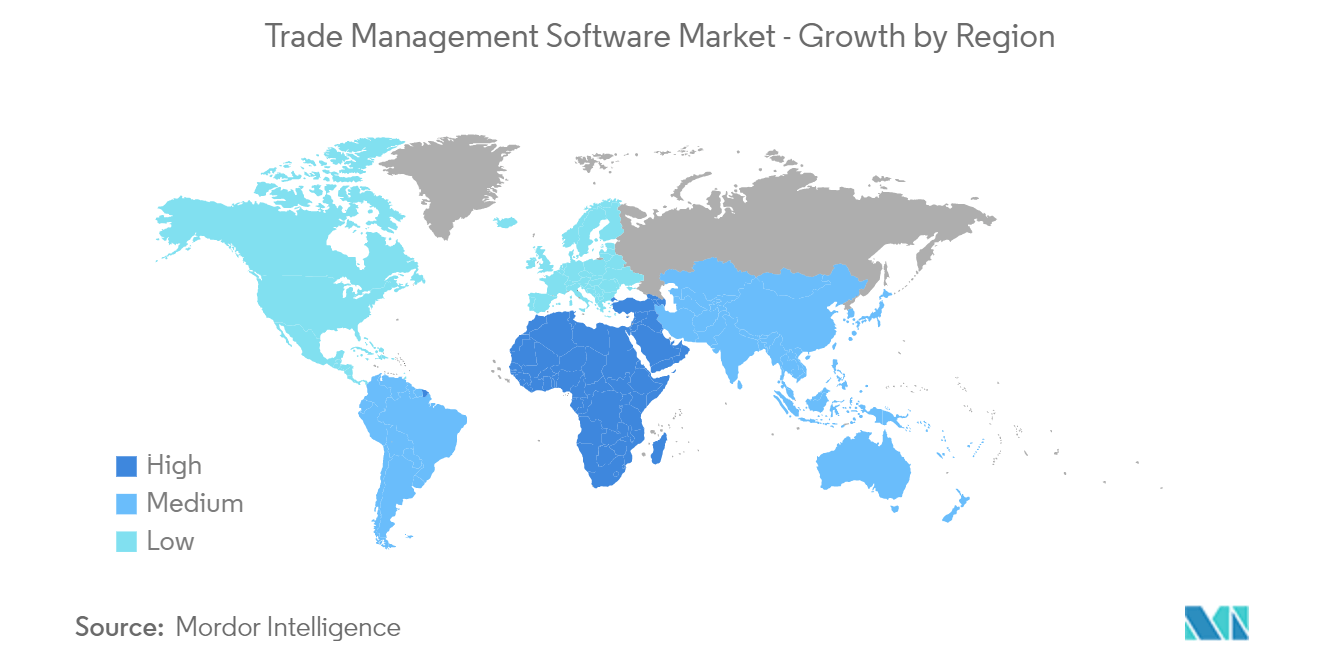
Trade Management Software Industry Overview
The global trade management software market consists of several players. The intensity of competitive rivalry in the market is expected to be moderately high over the forecast period.
- July 2022 - Livingston International, a provider of customs brokerage, freight forwarding, and global trade advisory solutions, announced the launch of Livingston Direct, a wholly digital, user-directed platform that gives United States importers greater visibility and control over online customs clearance. The launch of Livingston Direct is the company's latest initiative in its ongoing effort to provide enhanced digital services to businesses looking to simplify the customs process.
- April 2022 - Thomson Reuters, the worldwide source of intelligent information for businesses and professionals, acquired Gestta Technology Ltda. ("Gestta"), is an accounting automation software company previously a part of the Redspark Group. The acquisition provides additional technology and human expertise to accelerate the digital transformation of Brazilian accounting firms. Moreover, Gestta's accounting software solution enables customers to automate workflows, people management, customer service, and secure document archiving, among other things. More than 6,00,000 companies and organizations are registered in Gestta's firm customers' systems.
Trade Management Software Market Leaders
Oracle Corporation
Expeditors International of Washington, Inc.
Amber Road Inc. (E2open)
SAP SE
Livingston International
*Disclaimer: Major Players sorted in no particular order
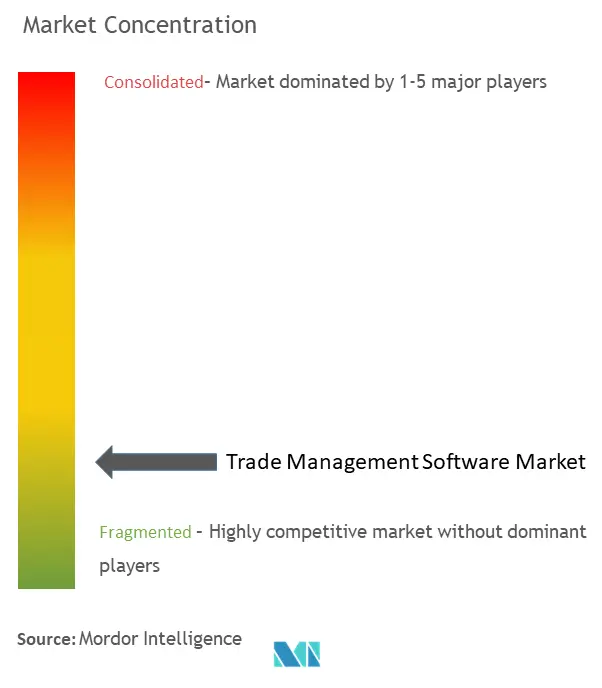
Trade Management Software Market News
- November 2022 - SAP presented Build, a new low-code platform that could bring software development to business users such as marketers and procurement experts. Essentially, SAP combines existing products in Build to simplify the development of apps, processes, and websites.
- September 2022 - E2open and Shippeo, a global provider of real-time multimodal transportation visibility, expand partnerships to deliver native real-time in-transit visibility in the most comprehensive global supply chain management platform. Customers will benefit from real-time data, visibility of goods in motion, and the ability to take relevant action on a single connected platform due to the expanded partnership with e2open.
Trade Management Software Market Report - Table of Contents
1. INTRODUCTION
1.1 Study Assumptions and Market Definition
1.2 Scope of the Study
2. RESEARCH METHODOLOGY
3. EXECUTIVE SUMMARY
4. MARKET INSIGHTS
4.1 Market Overview
4.2 Industry Value Chain Analysis
4.3 Industry Attractiveness - Porter's Five Forces Analysis
4.3.1 Bargaining Power of Suppliers
4.3.2 Bargaining Power of Consumers
4.3.3 Threat of New Entrants
4.3.4 Threat of Substitutes
4.3.5 Intensity of Competitive Rivalry
4.4 An Assessment of The Impact of COVID-19 on The Market
5. MARKET DYNAMICS
5.1 Market Drivers
5.1.1 Efficient Handling of Global Trade
5.1.2 Increasing Government Regulations in International Trade
5.2 Market Restraints
5.2.1 Slow Adoption Rates Among Organizations
6. MARKET SEGMENTATION
6.1 By Component
6.1.1 Solution
6.1.1.1 Vendor Management
6.1.1.2 Import/Export Management
6.1.1.3 Invoice Management
6.1.1.4 Other Solutions (Finance, Compliance, Etc.)
6.1.2 Service
6.1.2.1 Consulting
6.1.2.2 Implementation
6.2 By Deployment
6.2.1 On-Cloud
6.2.2 On-Premise
6.3 By Organization Size
6.3.1 Small and Medium Enterprises
6.3.2 Large Enterprises
6.4 By End-user Industry
6.4.1 Defense
6.4.2 Pharmaceuticals
6.4.3 Energy
6.4.4 Transportation and Logistics
6.4.5 Consumer Goods
6.4.6 Other End-user Industries
6.5 By Geography
6.5.1 North America
6.5.2 Europe
6.5.3 Asia Pacific
6.5.4 Latin America
6.5.5 Middle East and Africa
7. COMPETITIVE LANDSCAPE
7.1 Company Profiles
7.1.1 Oracle Corporation
7.1.2 Expeditors International of Washington Inc.
7.1.3 Amber Road Inc. (E2open)
7.1.4 SAP SE
7.1.5 Livingston International
7.1.6 Thomson Reuters Corporation
7.1.7 Cognizant
7.1.8 United Parcel Service of America Inc.
7.1.9 The Descartes Systems Group Inc.
7.1.10 MIC
7.1.11 Bamboo Rose LLC
7.1.12 OCR Services Inc.
- *List Not Exhaustive
8. INVESTMENT ANALYSIS
9. FUTURE OF THE MARKET
Trade Management Software Industry Segmentation
Trade management software helps companies manage their trade operations around the world. It is used chiefly by importers and exporters to improve collaboration with trade partners and manage global trade operations.
The Trade Management Software Market is segmented by component (solutions (vendor management, import/export management, invoice management, and other solutions (finance, compliance, etc.)), services (consulting, implementation)), deployment (on-cloud, on-premise), organization size (small & medium enterprises, large enterprises), end-user industry (defense, pharmaceuticals, energy, transportation & logistics, consumer goods, and other end-user industries), and geography (North America, Europe, Asia Pacific, Latin America, Middle East & Africa). The market sizes and forecasts are in terms of value (USD billion) for all the above segments.
| By Component | ||||||
| ||||||
|
| By Deployment | |
| On-Cloud | |
| On-Premise |
| By Organization Size | |
| Small and Medium Enterprises | |
| Large Enterprises |
| By End-user Industry | |
| Defense | |
| Pharmaceuticals | |
| Energy | |
| Transportation and Logistics | |
| Consumer Goods | |
| Other End-user Industries |
| By Geography | |
| North America | |
| Europe | |
| Asia Pacific | |
| Latin America | |
| Middle East and Africa |
Trade Management Software Market Research FAQs
How big is the Trade Management Software Market?
The Trade Management Software Market size is expected to reach USD 1.20 billion in 2023 and grow at a CAGR of 9.90% to reach USD 1.92 billion by 2028.
What is the current Trade Management Software Market size?
In 2023, the Trade Management Software Market size is expected to reach USD 1.20 billion.
Who are the key players in Trade Management Software Market?
Oracle Corporation, Expeditors International of Washington, Inc., Amber Road Inc. (E2open), SAP SE and Livingston International are the major companies operating in the Trade Management Software Market.
Which is the fastest growing region in Trade Management Software Market?
Middle East and Africa is estimated to grow at the highest CAGR over the forecast period (2023-2028).
Which region has the biggest share in Trade Management Software Market?
In 2023, the North America accounts for the largest market share in the Trade Management Software Market.
Trade Management Software Industry Report
Statistics for the 2023 Trade Management Software market share, size and revenue growth rate, created by Mordor Intelligence™ Industry Reports. Trade Management Software analysis includes a market forecast outlook to 2028 and historical overview. Get a sample of this industry analysis as a free report PDF download.
